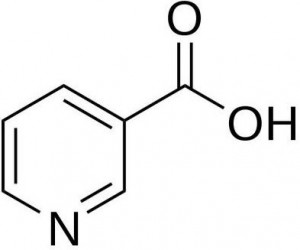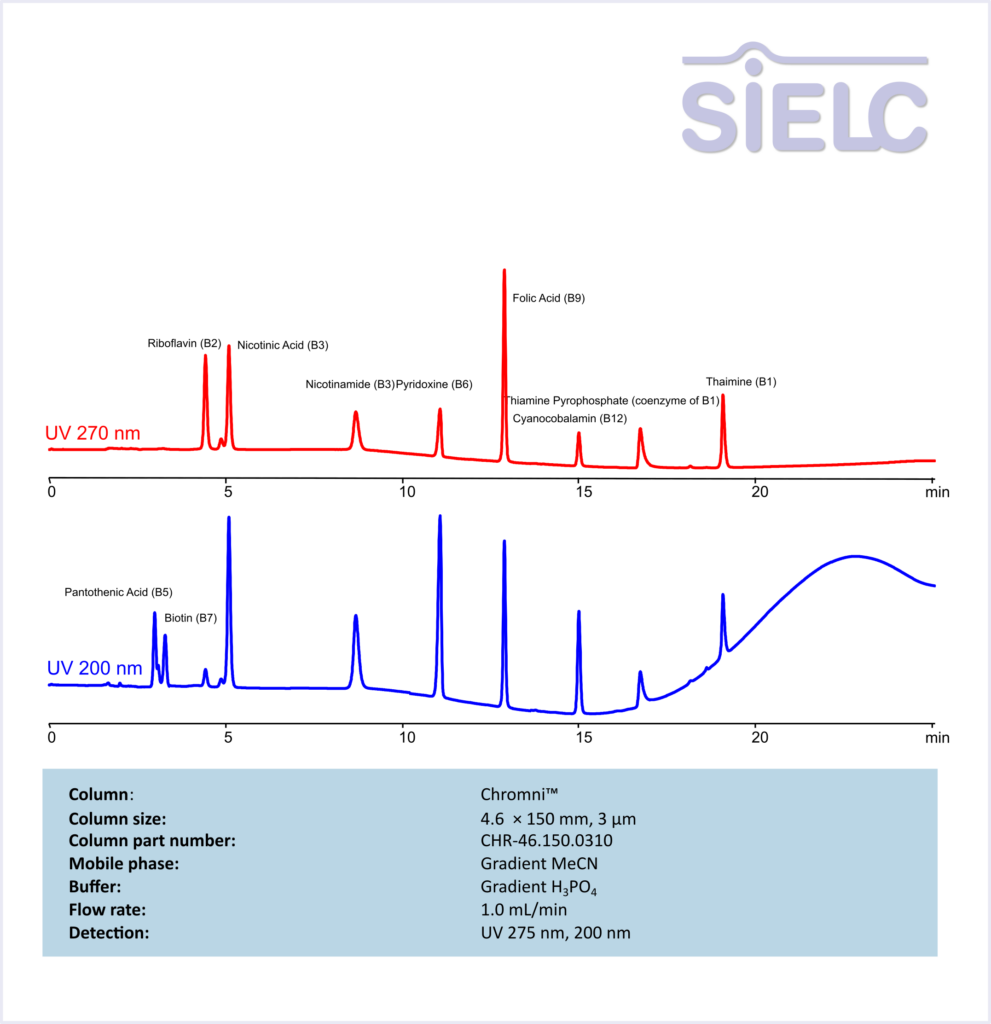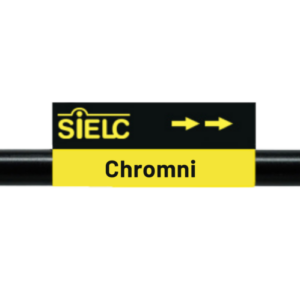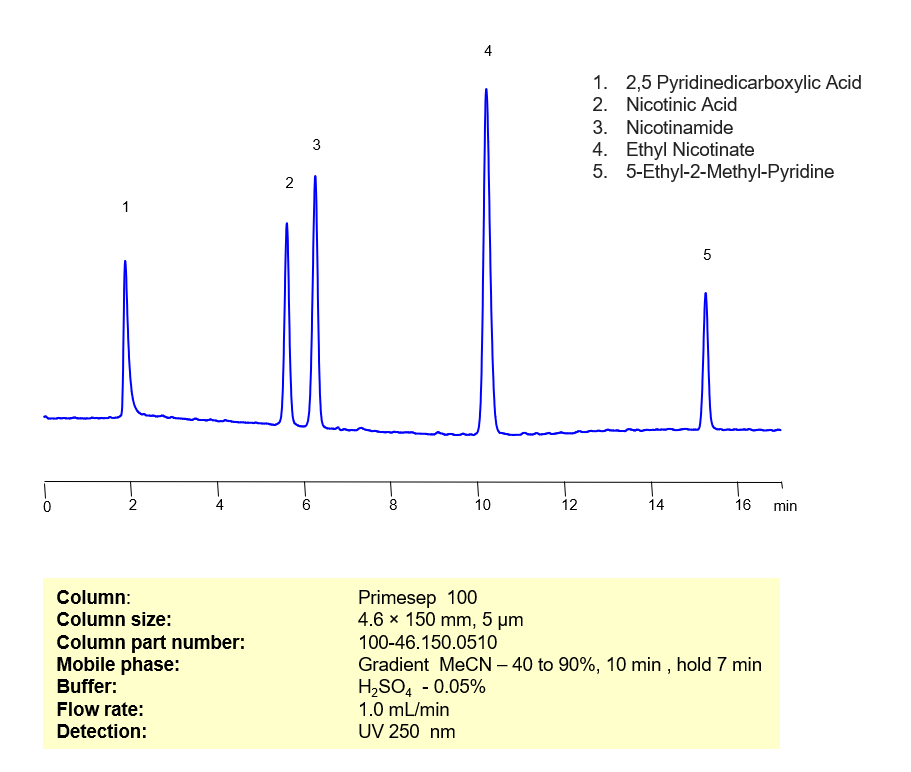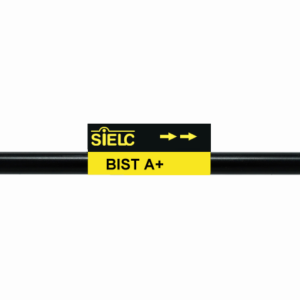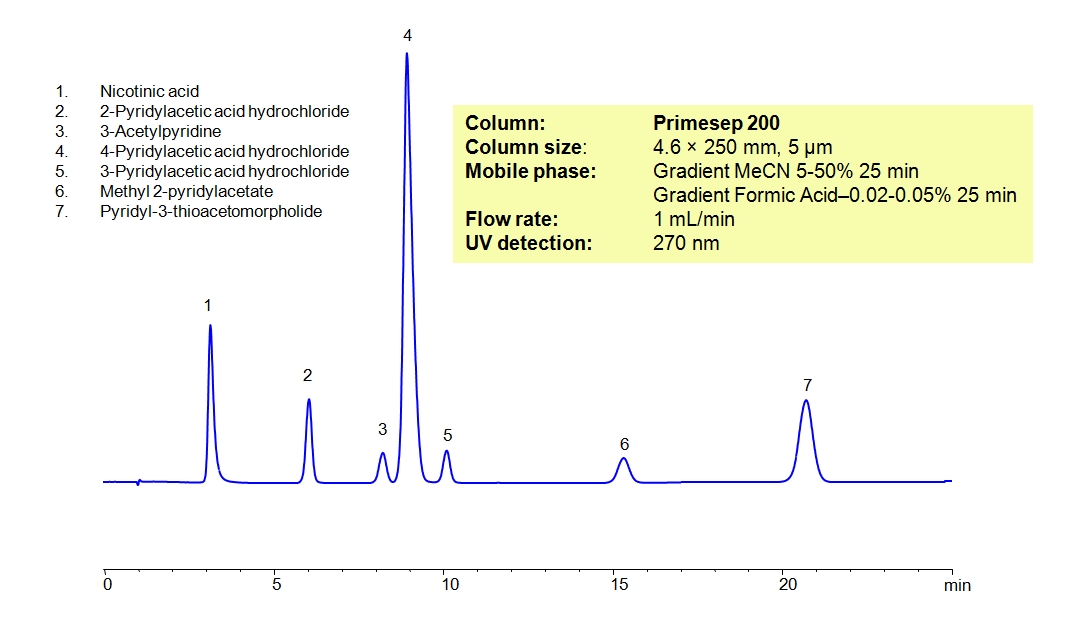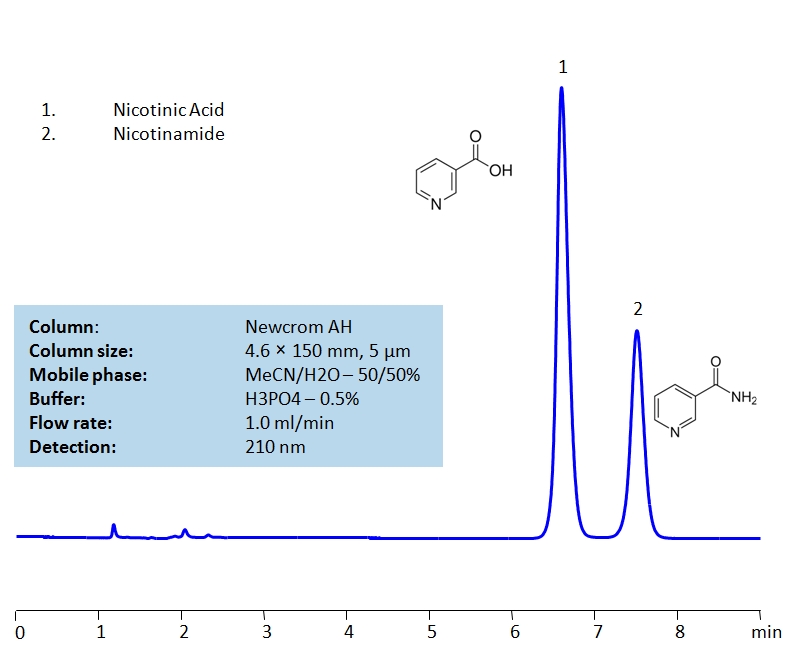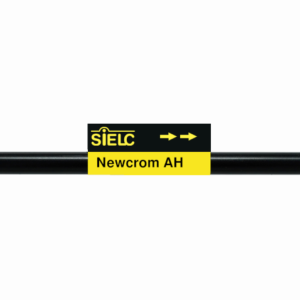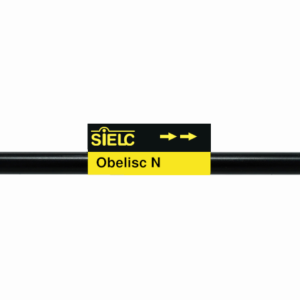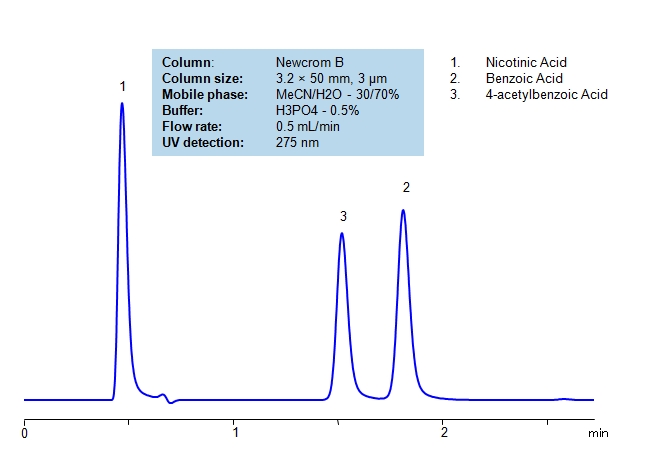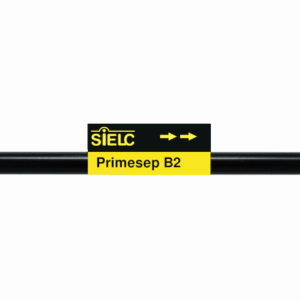| CAS Number | 59-67-6 |
|---|---|
| Molecular Formula | C6H5NO2 |
| Molecular Weight | 123.111 |
| InChI Key | PVNIIMVLHYAWGP-UHFFFAOYSA-N |
| LogP | 0.4 |
| Synonyms |
|
Applications:
UV-Vis Spectrum of Nicotinic Acid (Niancin)
December 24, 2025
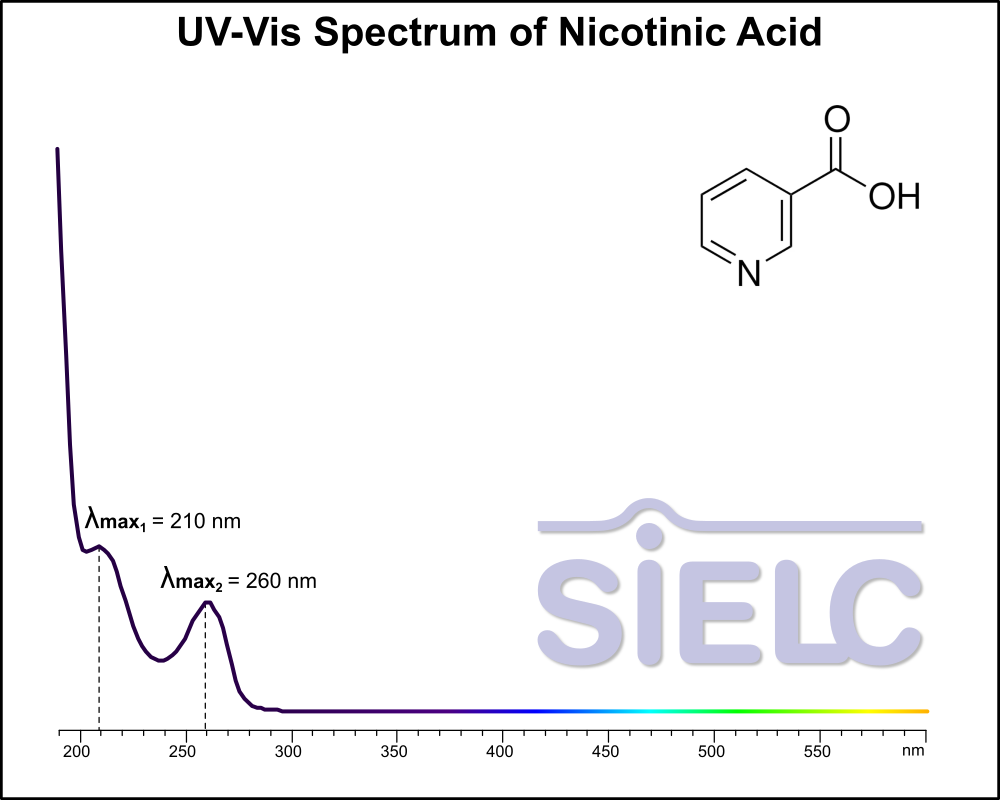
If you are looking for optimized HPLC method to analyze Nicotinic Acid/Niacin (3-pyridinecarboxylic acid) check our HPLC Applications library
For optimal results in HPLC analysis, it is recommended to measure absorbance at a wavelength that matches the absorption maximum of the compound(s) being analyzed. The UV spectrum shown can assist in selecting an appropriate wavelength for your analysis. Please note that certain mobile phases and buffers may block wavelengths below 230 nm, rendering absorbance measurement at these wavelengths ineffective. If detection below 230 nm is required, it is recommended to use acetonitrile and water as low UV-transparent mobile phases, with phosphoric acid and its salts, sulfuric acid, and TFA as buffers.
For some compounds, the UV-Vis Spectrum is affected by the pH of the mobile phase. The spectra presented here are measured with an acidic mobile phase that has a pH of 3 or lower.

HPLC Method for Separation of 10 Water-Soluble Vitamins on Chromni Column
September 17, 2025
HPLC Method for Separation of 10 Water-Soluble Vitamins on Chromni™ by SIELC Technologies
High Performance Liquid Chromatography (HPLC) Method for separation of Vitamin B2 (Riboflavin), Nicotinic Acid/Niacin (3-pyridinecarboxylic acid), Nicotinamide, Vitamin B6 (Pyridoxine), Folic Acid, Cyanocobalamin, Thiamine diphosphate (Thiamine pyrophosphate), Vitamin B1 (Thiamine), Pantothenic Acid, Biotin
Riboflavin (B2), Nicotinic Acid (B3), Nicotinamide (B3), Pyridoxine (B6), Folic Acid (B9), Cyanocobalamin (B12), Thiamine Pyrophosphate (coenzyme of B1), Thiamine (B1), Pantothenic Acid (B5), Biotin (B7) are water soluble vitamins with a key function of energy metabolism. These coenzymes are responsible for converting food into usable energy.
Vitamin B2 (Riboflavin), Nicotinic Acid/Niacin (3-pyridinecarboxylic acid), Nicotinamide, Vitamin B6 (Pyridoxine), Folic Acid, Cyanocobalamin, Thiamine diphosphate (Thiamine pyrophosphate), Vitamin B1 (Thiamine), Pantothenic Acid, Biotin can be retained and analyzed using the Chromni™ stationary phase column. The analysis utilizes a gradient method with a simple mobile phase consisting of water, acetonitrile (MeCN). Detection is performed using UV.
| Column | Chromni™, 4.6 x 150 mm, 3 µm, 100 A, dual ended |
| Mobile Phase | MeCN/H2O – see table |
| Buffer | H3PO4 – see table |
| Flow Rate | 1.0 ml/min |
| Detection | UV 275 nm, 200 nm |
Gradient Elution Program for HPLC Method
| Time (min) | A – H2O (%) | B – MeCN (%) | C – H3PO4 1% in H2O (%) | Notes |
| 0 | 0 | 90 | 10 | Starting Conditions (Hold) |
| 4 | 0 | 90 | 10 | Gradient Start |
| 20 | 20 | 30 | 50 | Gradient End |
| 20.01 | 0 | 90 | 10 | Column Equilibration |
| 30 | 0 | 90 | 10 | End of Run |
| Class of Compounds | Vitamins |
| Analyzing Compounds | Vitamin B2 (Riboflavin), Nicotinic Acid/Niacin (3-pyridinecarboxylic acid), Nicotinamide, Vitamin B6 (Pyridoxine), Folic Acid, Cyanocobalamin, Thiamine diphosphate (Thiamine pyrophosphate), Vitamin B1 (Thiamine), Pantothenic Acid, Biotin |
Application Column
Chromni™
Column Diameter: 4.6 mm
Column Length: 150 mm
Particle Size: 3 µm
Pore Size: 100 A
Column options: dual ended
Cyanocobalamin
Folic Acid
Nicotinamide
Nicotinic Acid/Niacin (3-pyridinecarboxylic acid)
Pantothenic Acid
Thiamine diphosphate (Thiamine pyrophosphate)
Vitamin B1 (Thiamine)
Vitamin B2 (Riboflavin)
Vitamin B6 (Pyridoxine)

HPLC Method for Separation of Nicotinic Acid, Nicotinamide, Tranexamic Acid on Primesep 100 Column
March 28, 2024
HPLC Method for Separation of Nicotinic Acid, Nicotinamide, Tranexamic Acid on Primesep 100 Column
Separation type: Liquid Chromatography Mixed-mode SIELC Technologies
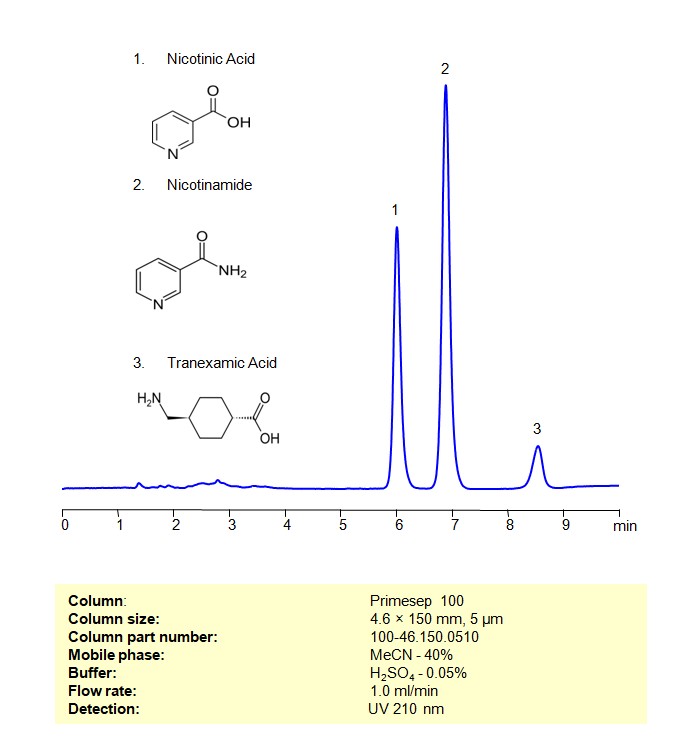
High Performance Liquid Chromatography (HPLC) Method for Analysis of Nicotinic Acid/Niacin (3-pyridinecarboxylic acid), Nicotinamide, Tranexamic acid
Nicotinic acid and nicotinamide are both forms of vitamin B3, also known as niacin. They play crucial roles in the body’s energy metabolism and are essential for maintaining the health of the skin, nervous system, and digestive system.
- Nicotinic Acid (Niacin): This is one of the two principal forms of vitamin B3. Nicotinic acid is commonly used as a dietary supplement to treat vitamin B3 deficiency, and it’s also prescribed in higher doses to help lower cholesterol levels. It works by dilating blood vessels, which can lead to a flushing sensation, hence it is sometimes referred to as “flushing niacin.”
- Nicotinamide: Also known as niacinamide, this is the other principal form of vitamin B3. Nicotinamide is a precursor to nicotinamide adenine dinucleotide (NAD+), a coenzyme involved in various cellular processes, including energy metabolism. Nicotinamide is often used in skincare products for its anti-inflammatory properties and its ability to improve the appearance of aging skin and reduce hyperpigmentation.
Tranexamic acid, on the other hand, is a synthetic derivative of the amino acid lysine. It is primarily used as an antifibrinolytic agent, meaning it helps to prevent the breakdown of blood clots. Tranexamic acid is commonly used to treat or prevent excessive bleeding, particularly in conditions such as heavy menstrual bleeding, traumatic hemorrhage, and during surgeries where significant blood loss is expected. Additionally, it has been investigated for its potential role in treating melasma, a common skin condition characterized by hyperpigmentation.
Each of these compounds has distinct biochemical properties and medical applications, but they all play important roles in human health and medicine.
Nicotinic Acid, Nicotinamide, Tranexamic Acid can be retained and separated using a Primesep 100 mixed-mode stationary phase column. The analysis employs an isocratic method with a simple mobile phase comprising water, acetonitrile (MeCN), and sulfuric acid as a buffer. This method allows for detection using UV at 210 nm
| Column | Primesep 100, 4.6 x 150 mm, 5 µm, 100 A, dual ended |
| Mobile Phase | MeCN 40% |
| Buffer | H2SO4 – 0.05% |
| Flow Rate | 1.0 ml/min |
| Detection | UV 210nm |
| Class of Compounds | Acids |
| Analyzing Compounds | Nicotinic Acid/Niacin (3-pyridinecarboxylic acid), Nicotinamide, Tranexamic acid |
Application Column
Primesep 100
Column Diameter: 4.6 mm
Column Length: 150 mm
Particle Size: 5 µm
Pore Size: 100 A
Column options: dual ended
Nicotinic Acid/Niacin (3-pyridinecarboxylic acid)
Tranexamic acid

HPLC Method for Simultaneous Determination of Nicotinic Acid, Nicotinamide, Pyridine Dicarboxylic Acid, Ethyl Methyl Pyridine and Ethyl Nicotinate on Primesep 100 Column
August 29, 2022
HPLC Method for Nicotinic Acid/Niacin (3-pyridinecarboxylic acid), Nicotinamide, Pyridinedicarboxylic Acid, 2,5-Pyridinedicarboxylic acid, 5-Ethyl-2-methylpyridine, Ethyl nicotinate on Primesep 100 by SIELC Technologies
High Performance Liquid Chromatography (HPLC) Method for Analysis of Nicotinic Acid/Niacin (3-pyridinecarboxylic acid), Nicotinamide, Pyridinedicarboxylic Acid, 2,5-Pyridinedicarboxylic acid, 5-Ethyl-2-methylpyridine, Ethyl nicotinate.
2,5-Pyridinedicarboxylic acid (PDA), also known as Dipicolinic acid (DPA), is a key factor in bacterial endospore heat resistance. It also plays an important role in preparing transition metal complexes for ion chromatography.
Nicotinic acid, also known as niacin, is a water-soluble B vitamin with C6H5NO2 molecular formula. It is an essential nutrient that plants and animals synthesize from tryptophan. It is also used as a dietary supplement to treat pellagra, which is characterized by dermatitis of sunlight-exposed skin and is said to be caused by a corn-based diet. Nicotinic acid was found on asteroids and meteorites.
Nicotinamide, also known as niacinaminde, is a form of vitamin B3 with the chemical formula C6H6N2O2. It is preferred treatment for pellagra and is a common treatment for acne due to it’s anti-inflammatory properties. If consumed daily, it is shown to decrease the risk of skin cancers other than melanoma. It is a derivative of Nicotinic acid and is a key component of the coenzymes nicotinamide adenine dinucleotide (NAD) and nicotinamide adenine dinucleotide phosphate (NADP+). You can find detailed UV spectra of Nicotinamide and information about its various lambda maxima by visiting the following link.
Ethyl nicotinate, also known as nicotine acid ethyl ester, has the chemical formula C8H9NO2. It is a popular topical treatment for ligament, joint, and muscle pain.
5-Ethyl-2-methylpyridine is a common precursor to Nicotinic acid with the chemical formula C8H11N. It is produced by condensation of paraldehyde and ammonia.
Nicotinic Acid/Niacin (3-pyridinecarboxylic acid), Nicotinamide, Pyridinedicarboxylic Acid, 2,5-Pyridinedicarboxylic acid, 5-Ethyl-2-methylpyridine, Ethyl nicotinate can be separated, retained, and analyzed on a Primesep 100 mixed-mode column using an analytical method with a simple gradient mobile phase of water, Acetonitrile (MeCN), and a sulfuric acid (H2SO4) buffer. This analysis method can be UV detected at 250 nm with high resolution and peak symmetry.
| Column | Primesep 100, 4.6 x 150 mm, 5 µm, 100 A, dual ended |
| Mobile Phase | MeCN – Gradient |
| Buffer | H2SO4 – 0.05% |
| Flow Rate | 1.0 ml/min |
| Detection | UV 250 nm |
| Class of Compounds | Drug, Acid |
| Analyzing Compounds | Nicotinic Acid/Niacin (3-pyridinecarboxylic acid), Nicotinamide, Pyridinedicarboxylic Acid, 2,5-Pyridinedicarboxylic acid, 5-Ethyl-2-methylpyridine, Ethyl nicotinate |
Application Column
Primesep 100
Column Diameter: 4.6 mm
Column Length: 150 mm
Particle Size: 5 µm
Pore Size: 100 A
Column options: dual ended
5-Ethyl-2-methylpyridine
Ethyl nicotinate
Nicotinamide
Nicotinic Acid/Niacin (3-pyridinecarboxylic acid)
Pyridinedicarboxylic Acid

HPLC Method for Analysis of Maleic acid, Ascorbic acid, Nicotinic acid, Fumaric acid and Oxalic acid on BIST™ A+ Column
July 8, 2022
Separation type: Bridge Ion Separation Technology, or BIST™ by SIELC Technologies
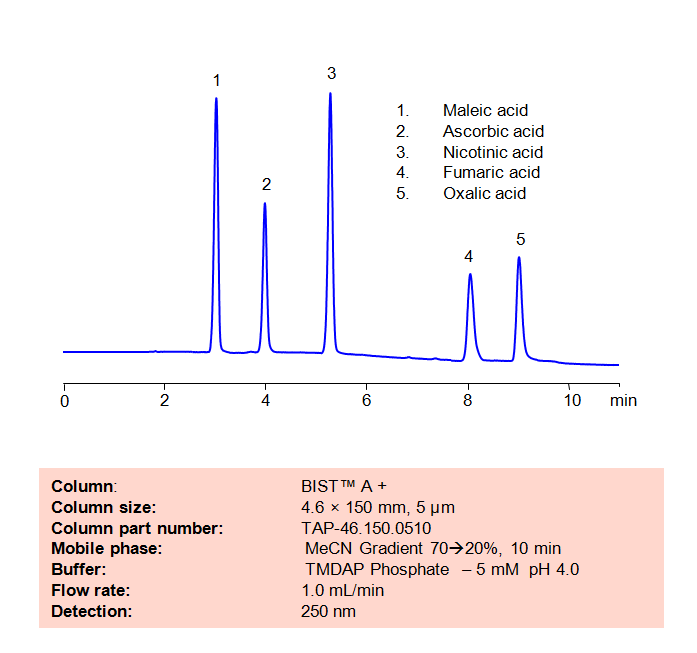
High Performance Liquid Chromatography (HPLC) Method for Analysis of Maleic acid, Ascorbic acid, Nicotinic acid, Fumaric acid and Oxalic acid
The maleate ion from Maleic acid is a popular ingredient as the maleate salt in several different drugs, including Methergine, Pyrilamine, and Carfenazine, among others. Nicotinic acid, also known as Niacin or Vitamin B3, is an essential nutrient for the human body and is sometimes taken as a treatment for high cholesterol. Aconitic acid is a key intermediary in the citric acid cycle, and is also used a flavoring agent and in the production of rubbers and plastics. Fumaric acid is a popular preservative and food additive with a fruit-like taste. Using SIELC’s newly introduced BIST™ method, a mixture of these organic acids can be separated on a negatively-charged, cation-exchange BIST™ A+ column, contrary to conventional chromatographic wisdom. There are two keys to this retention method: 1) a multi-charged, positive buffer, such as N,N,N’,N’-Tetramethyl-1,3-propanediamine (TMDAP), which acts as a bridge, linking the negatively-charged anion analytes to the negatively-charged column surface and 2) a mobile phase consisting mostly of organic solvent (such as MeCN) to minimize the formation of a solvation layer around the charged analytes. Other positively-charged buffers that can generate BIST™ include Calcium acetate and Magnesium acetate. Using this new and unique analysis method, these organic acids can be separated, retained, and detected through ELSD. This method is also compatible with Mass Spectrometry (LC-MS) and CAD.
Condition
| Column | BIST™ A+, 4.6×150 mm, 5 µm, 100A |
| Mobile Phase | MeCN Gradient |
| Buffer | TMDAP ( N,N,N’,N’-Tetramethyl-1,3-diaminopropane) phosphate – 5 mM pH 4.0 |
| Flow Rate | 1.0 ml/min |
| Detection | UV 250 nm |
Description
| Class of Compounds | Acids, Organic acid |
| Analyzing Compounds | Maleic acid, Ascorbic acid, Nicotinic acid, Fumaric acid and Oxalic acid |
Application Column
BIST A+
BIST™ columns offer a unique and effective way to achieve separations that were traditionally challenging or even impossible with other HPLC columns. With the use of a special mobile phase, these ion exchange columns provide very strong retention for analytes with the same charge polarity as the stationary phase, unlocking new chromatography applications. What makes BIST™ columns stand out is their proprietary surface chemistry, which results in superior selectivity, resolution, and sensitivity. These columns offer a simple, efficient solution for a variety of analytical challenges, making them an excellent choice for researchers and analysts across many different fields. To learn more about the technology that powers BIST™ columns and to explore related applications, check out https://BIST.LC.
Select optionsFumaric Acid
Maleic Acid
Nicotinic Acid/Niacin (3-pyridinecarboxylic acid)
Oxalic Acid

HPLC Method for Analysis of Maleic Acid, Nicotinic Acid, Aconitic Acid and Fumaric Acid on BIST™ A+ Column
July 7, 2022
Separation type: Bridge Ion Separation Technology, or BIST™ by SIELC Technologies
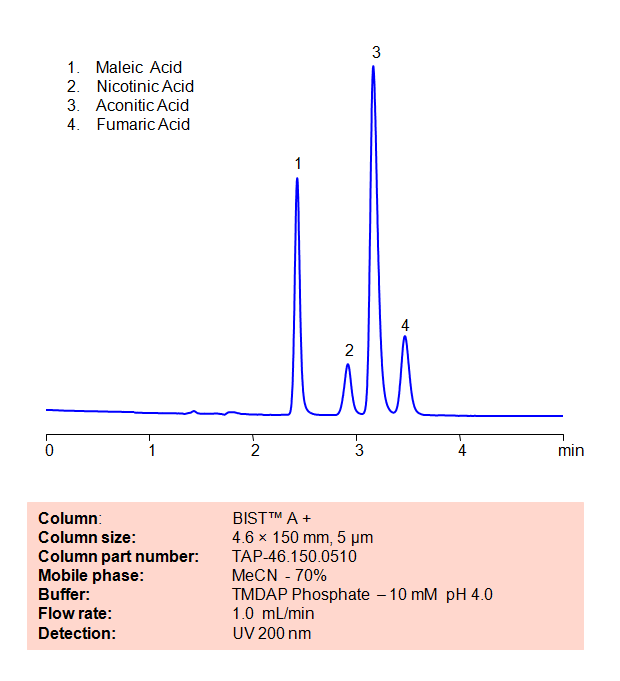
The maleate ion from Maleic acid is a popular ingredient as the maleate salt in several different drugs, including Methergine, Pyrilamine, and Carfenazine, among others. Nicotinic acid, also known as Niacin or Vitamin B3, is an essential nutrient for the human body and is sometimes taken as a treatment for high cholesterol. Aconitic acid is a key intermediary in the citric acid cycle, and is also used a flavoring agent and in the production of rubbers and plastics. Fumaric acid is a popular preservative and food additive with a fruit-like taste. Using SIELC’s newly introduced BIST™ method, a mixture of these organic acids can be separated on a negatively-charged, cation-exchange BIST™ A+ column, contrary to conventional chromatographic wisdom. There are two keys to this retention method: 1) a multi-charged, positive buffer, such as N,N,N’,N’-Tetramethyl-1,3-propanediamine (TMDAP), which acts as a bridge, linking the negatively-charged anion analytes to the negatively-charged column surface and 2) a mobile phase consisting mostly of organic solvent (such as MeCN) to minimize the formation of a solvation layer around the charged analytes.
Condition
| Column | BIST™ A+, 4.6×150 mm, 5 µm, 100A |
| Mobile Phase | MeCN – 70% |
| Buffer | TMDAP ( N,N,N’,N’-Tetramethyl-1,3-diaminopropane) Phosphate – 10 mM pH 4.0 |
| Flow Rate | 1.0 ml/min |
| Detection | UV 200 nm |
Description
| Class of Compounds | Acid, Dicarboxylic acid, Tricarboxylic acid, Pyridinecarboxylic acid |
| Analyzing Compounds | Maleic Acid, Nicotinic Acid, Aconitic Acid, Fumaric Acid |
Application Column
BIST A+
BIST™ columns offer a unique and effective way to achieve separations that were traditionally challenging or even impossible with other HPLC columns. With the use of a special mobile phase, these ion exchange columns provide very strong retention for analytes with the same charge polarity as the stationary phase, unlocking new chromatography applications. What makes BIST™ columns stand out is their proprietary surface chemistry, which results in superior selectivity, resolution, and sensitivity. These columns offer a simple, efficient solution for a variety of analytical challenges, making them an excellent choice for researchers and analysts across many different fields. To learn more about the technology that powers BIST™ columns and to explore related applications, check out https://BIST.LC.
Select optionsFumaric Acid
Maleic Acid
Nicotinic Acid/Niacin (3-pyridinecarboxylic acid)
trans-Aconitic acid

HPLC Separation Of Mixture of Pyridylacetic Acids And Their Derivatives
May 23, 2018
HPLC Method for 2-Pyridylacetic acid hydrochloride, 3-Pyridylacetic acid hydrochloride, 4-Pyridylacetic acid hydrochloride, Nicotinic Acid/Niacin (3-pyridinecarboxylic acid), 3-Acetylpyridine, Pyridyl-3-thioacetomorpholide on Primesep 200 by SIELC Technologies
High Performance Liquid Chromatography (HPLC) Method for Analysis of 2-Pyridylacetic acid hydrochloride, 3-Pyridylacetic acid hydrochloride, 4-Pyridylacetic acid hydrochloride, Nicotinic Acid/Niacin (3-pyridinecarboxylic acid), 3-Acetylpyridine, Pyridyl-3-thioacetomorpholide
Pyridylacetic Acids are a class of compounds with a pyridine ring and an acetic acid. These acids are typically building blocks found in organic synthesis/ On occasion, they can also act as human xenobiotic metabolites.
Nicotinic acid, also known as niacin and vitamin B3, is a water-soluble B vitamin with C₆H₅NO₂ molecular formula. It is crucial for energy production.
Derrivatives are compounds formed when the parent compound goes through a chemical recation, replacing atoms with different ones, leading to different physical and chemical properties.
2-Pyridylacetic acid hydrochloride, 3-Pyridylacetic acid hydrochloride, 4-Pyridylacetic acid hydrochloride, Nicotinic Acid/Niacin (3-pyridinecarboxylic acid), 3-Acetylpyridine, Pyridyl-3-thioacetomorpholide can be retained and analyzed using the Primesep 200 stationary phase column. The analysis utilizes a gradient method with a simple mobile phase consisting of water and acetonitrile (MeCN) with a formic acid buffer. Detection is performed using UV.
| Column | Primesep 200, 4.6 x 250 mm, 5 µm, 100 A, dual ended |
| Mobile Phase | MeCN/H2O Gradient – 5-50% |
| Buffer | CH2O2 – 0.02-0.05% |
| Flow Rate | 1.0ml/min |
| Detection | UV, 270 nm |
| Class of Compounds | Acids |
| Analyzing Compounds | 2-Pyridylacetic acid hydrochloride, 3-Pyridylacetic acid hydrochloride, 4-Pyridylacetic acid hydrochloride, Nicotinic Acid/Niacin (3-pyridinecarboxylic acid), 3-Acetylpyridine, Pyridyl-3-thioacetomorpholide |
Application Column
Primesep 200
Column Diameter: 4.6 mm
Column Length: 250 mm
Particle Size: 5 µm
Pore Size: 100 A
Column options: dual ended
3-Acetylpyridine
3-Pyridylacetic acid hydrochloride
4-Pyridylacetic acid hydrochloride
Nicotinic Acid/Niacin (3-pyridinecarboxylic acid)
Pyridyl-3-thioacetomorpholide

Analysis of Nicotinic Acid and Nicotinamide (Vitamin B3) on Newcrom AH Column
July 6, 2015
Nicotinamide is the amide form of nicotinic acid. Nicotinic acid is in the vitamin B group and is converted to nicotinamide in vivo. Newcrom AH was used to separate nicotinamide and nicotinic acid. Newcrom AH separates acids using ion-exclusion, retains basic compounds by cation-exchange, and neutral compounds by reverse-phase mechanism.
| Column | Newcrom AH, 4.6×150 mm, 5 µm, 100A |
| Mobile Phase | MeCN/H2O – 50/50% |
| Buffer | H3PO4 – 0.5% |
| Flow Rate | 1.0 ml/min |
| Detection | UV, 210 nm |
| Class of Compounds |
Acid, Hydrophilic, Ionizable, Vitamin, Supplements |
| Analyzing Compounds | Nicotinic Acid, Nicotinamide, Vitamin B3 |
Application Column
Newcrom AH
The Newcrom columns are a family of reverse-phase-based columns. Newcrom A, AH, B, and BH are all mixed-mode columns with either positive or negative ion-pairing groups attached to either short (25 Å) or long (100 Å) ligand chains. Newcrom R1 is a special reverse-phase column with low silanol activity.
Select optionsNicotinamide
Nicotinic Acid/Niacin (3-pyridinecarboxylic acid)

HPLC Separation of Pyridinecarboxylic Acids
March 27, 2011
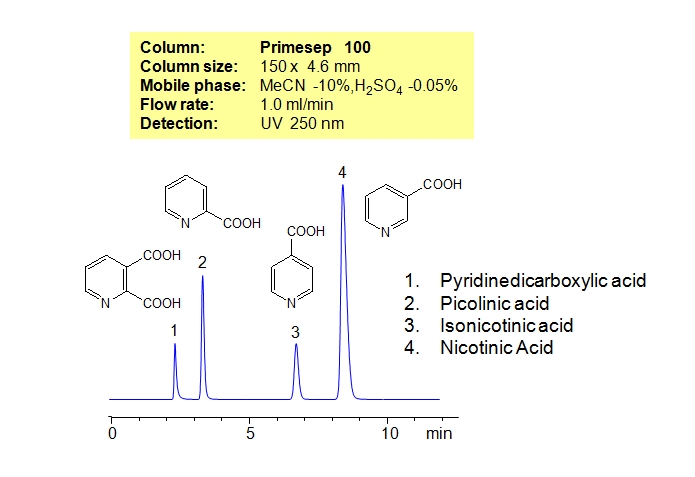
Pyridinecarboxylic acids exist as three isomers with different position of carboxylic acid relative to nitrogen in pyridine. Three isomers of pyridinecarboxylic acid (picolinic or 2-pyridinecarvoxylic acid, niacin or 3-pyridinecarboxylic acid, isonicotinic or 4-pyridinecarboxylic acid), along with pyridinedicarboxylic acid, are separated on a Primesep 100 column. Pyridinecarboxylic acids have a similar empirical formula, and are very similar in terms of hydrophobicity and ionic properties. Small differences in these properties are enough to achieve good separation on cation-exchange mixed-mode HPLC column like Primesep 100. Retention time for all compounds is controlled by the amount of acetonitrile and amount of ions in the mobile phase. Ions in the mobile phase can be created by organic and inorganic acids and corresponding salt buffers. Various detection techniques can be used for monitoring pyridinecarboxylic acids. Other ionizable isomers can be successfully separated on mixed-mode columns.
Application Column
Primesep 100
The Primesep family of mixed-mode columns offers a wide variety of stationary phases, boasting unprecedented selectivity in the separation of a broad array of chemical compounds across multiple applications. Corresponding Primesep guard columns, available with all stationary phases, do not require holders. SIELC provides a method development service available to all customers. Inquire about our specially-tailored custom LC-phases for specific separations.
Select optionsNicotinic Acid/Niacin (3-pyridinecarboxylic acid)
Organic Acids
Picolinic Acid
Pyridinedicarboxylic Acid

HPLC Separation of Vitamin C, Vitamin Group B, and Related Impurities
August 22, 2008
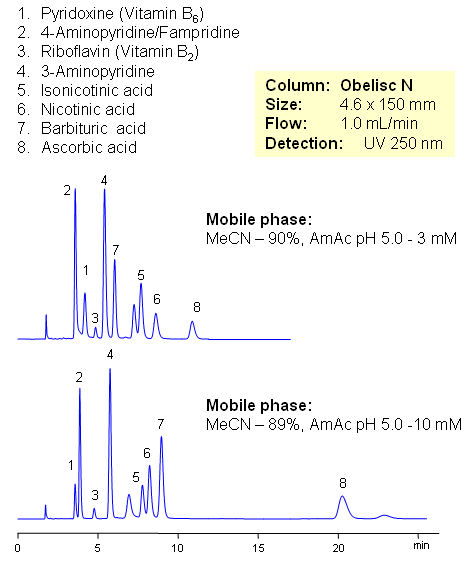
Vitamin C (ascorbic acid) and Vitamins Group B are separated on Obelisc N mixed-mode column. Method can be used in quantitation and determination of polar vitamins in various formulations and dietary supplements. HPLC method can be based on UV, Evaporative Light Scattering Detection (ESLD), RI or MS detection. Effect of sample matrix can be eliminated by changing mobile phase conditions. Buffer concentration, buffer pH and amount of ACN will affect every vitamin differently due to difference in polar and ionic properties.
| Column | Obelisc N , 4.6×150 mm, 5 µm, 100A |
| Mobile Phase | MeCN/H2O |
| Buffer | AmAc pH 5.0 |
| Flow Rate | 1.0 ml/min |
| Detection | UV, 250 nm |
| Class of Compounds |
Drug, Vitamin B₆, Hydrophobic, Ionizable |
| Analyzing Compounds | Pyridoxine, Ascorbic acid, Niacinamide, Pantothenic acid, Caffeine, Riboflavin, Barbituric Acid, 3- Aminopyrine |
Application Column
Obelisc N
SIELC has developed the Obelisc™ columns, which are mixed-mode and utilize Liquid Separation Cell technology (LiSC™). These cost-effective columns are the first of their kind to be commercially available and can replace multiple HPLC columns, including reversed-phase (RP), AQ-type reversed-phase, polar-embedded group RP columns, normal-phase, cation-exchange, anion-exchange, ion-exclusion, and HILIC (Hydrophilic Interaction Liquid Chromatography) columns. By controlling just three orthogonal method parameters - buffer concentration, buffer pH, and organic modifier concentration - users can adjust the column properties with pinpoint precision to separate complex mixtures.
Select options3-Aminopyridine
4-Aminopyridine/Fampridine
Ascorbic Acid
Barbituric Acid
Isonicotinic Acid
Nicotinic Acid/Niacin (3-pyridinecarboxylic acid)
Vitamin B2 (Riboflavin)
Vitamin B6 (Pyridoxine)

HPLC Separation of Carboxylic Acids
January 13, 2005
| Column | Newcrom B, 3.2×50 mm, 3 µm, 100A |
| Mobile Phase | MeCN/H2O- 30/70% |
| Buffer | H3PO4 – 0.5% |
| Flow Rate | 0.5 ml/min |
| Detection | UV, 275 nm |
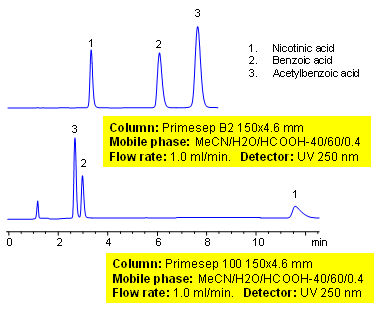
HPLC separation of carboxylic acids (nicotinic acid, benzoic acid and acetylbenzoic acid) on Primesep B2 column using an isocratic method by reverse-phase and anion-exchange mechanisms. The elution of carboxylic acids using the same isocratic method and mobile phase can be reversed by using a reverse-phase cation-exchange mechanisms of the Primesep 100 column. The mobile phase is water, acetonitrile (MeCN, ACN) and formic acid with a UV detector.
| Column | Primesep B2, 4.6×150 mm, 5 µm, 100A |
| Mobile Phase | MeCN/H2O |
| Buffer | Formic Acid |
| Flow Rate | 1.0 ml/min |
| Detection | UV, 250 nm |
| Class of Compounds |
Acid, Hydrophilic |
| Analyzing Compounds | Nicotinic acid, Benzoic acid, Acetylbenzoic acid,
1.4-acetylbenzoic Acid |
Application Column
Primesep 100
The Primesep family of mixed-mode columns offers a wide variety of stationary phases, boasting unprecedented selectivity in the separation of a broad array of chemical compounds across multiple applications. Corresponding Primesep guard columns, available with all stationary phases, do not require holders. SIELC provides a method development service available to all customers. Inquire about our specially-tailored custom LC-phases for specific separations.
Select optionsPrimesep B2
The Primesep family of mixed-mode columns offers a wide variety of stationary phases, boasting unprecedented selectivity in the separation of a broad array of chemical compounds across multiple applications. Corresponding Primesep guard columns, available with all stationary phases, do not require holders. SIELC provides a method development service available to all customers. Inquire about our specially-tailored custom LC-phases for specific separations.
Select optionsBenzoic Acid
Nicotinic Acid/Niacin (3-pyridinecarboxylic acid)

